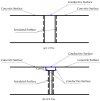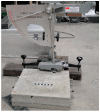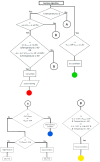A Novel Concrete-Based Sensor for Detection of Ice and Water on Roads and Bridges
- PMID: 29240710
- PMCID: PMC5750530
- DOI: 10.3390/s17122912
A Novel Concrete-Based Sensor for Detection of Ice and Water on Roads and Bridges
Abstract
Hundreds of people are killed or injured annually in the United States in accidents related to ice formation on roadways and bridge decks. In this paper, a novel embedded sensor system is proposed for the detection of black ice as well as wet, dry, and frozen pavement conditions on roads, runways, and bridges. The proposed sensor works by detecting changes in electrical resistance between two sets of stainless steel poles embedded in the concrete sensor to assess surface and near-surface conditions. A preliminary decision algorithm is developed that utilizes sensor outputs indicating resistance changes and surface temperature. The sensor consists of a 102-mm-diameter, 38-mm-high, concrete cylinder. Laboratory results indicate that the proposed sensor can effectively detect surface ice and wet conditions even in the presence of deicing chlorides and rubber residue. This sensor can further distinguish black ice from ice that may exist within concrete pores.
Keywords: black ice; bridge decks; concrete; electrical resistance; ice detection; pavements; safety.
Conflict of interest statement
The authors declare no conflict of interest.
Figures



















References
-
- Clifford M., Steed R. Roadway Icing and Weather: A Tutorial. [(accessed on 15 January 2014)]; Available online: http://www.atmos.washington.edu/cliff/Roadway2.htm.
-
- Robinson D. Icy Road Fatality Statistics. [(accessed on 15 January 2014)]; Available online: http://www.icyroadsafety.com/fatalitystats.shtml.
-
- Shimizu K., Nihei M., Dorémieux F. Effect of Texture of Iced Road Surface on Characteristics of Ice and Snow Tires. SAE International; Warrendale, PA, USA: 1992. SAE Technical Paper 920018.
-
- Praticò F.G., Vaiana R., Iuele T. Construction and Building Materials. Volume 95. Elsevier; Amsterdam, The Netherlands: 2015. Macrotexture Modeling and Experimental Validation for Pavement Surface Treatments; pp. 658–666.
-
- Iuele T., Vaiana R., Gallelli V., De Masi F. The Influence of Aggregate Lithological Nature on Pavement Texture Polishing: A Comparative Investigation on a Test Site in Southern Italy. Adv. Civ. Eng. Mater. 2016;5:337–352. doi: 10.1520/ACEM20160036. - DOI
LinkOut - more resources
Full Text Sources
Other Literature Sources

